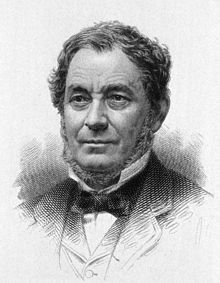Robert Wilhelm Bunsen
| Robert Bunsen | |
|---|---|
 |
|
| Born | Robert Wilhelm Eberhard Bunsen 30 March 1811[N1] Göttingen, Westphalia, Rhine Confederation (now Germany) |
| Died | 16 August 1899 (aged 88) Heidelberg, Baden, German Empire (now Germany) |
| Residence | Germany |
| Fields |
|
| Institutions | |
| Alma mater | University of Göttingen |
| Doctoral advisor | Friedrich Stromeyer |
| Doctoral students | |
| Other notable students | Dmitri Mendeleev |
| Known for | Discovery of cacodyl radical; discoveries of caesium and rubidium. Invention of the Bunsen burner; carbon-zinc electrochemical cell; methods of gas analysis; development of spectrochemical analysis |
| Notable awards |
|
Robert Wilhelm Eberhard Bunsen (/ˈbʌnsən/; German: [ˈbʊnzən]; 30 March 1811[N1] – 16 August 1899) was a German chemist. He investigated emission spectra of heated elements, and discovered caesium (in 1860) and rubidium (in 1861) with the physicist Gustav Kirchhoff. Bunsen developed several gas-analytical methods, was a pioneer in , and did early work in the field of organoarsenic chemistry. With his laboratory assistant, Peter Desaga, he developed the Bunsen burner, an improvement on the laboratory burners then in use. The Bunsen–Kirchhoff Award for spectroscopy is named after Bunsen and Kirchhoff.
Robert Bunsen was born at Göttingen in 1811, in what is now the state of Lower Saxony in Germany. Bunsen was the youngest of four sons of the University of Göttingen's chief librarian and professor of modern philology, Christian Bunsen (1770–1837).Sources disagree on Robert Bunsen's exact birth date. His parish register, as well as two curricula vitae handwritten by Bunsen himself, support the claim that 30 March 1811 is Bunsen's true birth date; however, many later sources cite 31 March as the date. According to his biographer , Bunsen himself celebrated his birthday on the 31st in his later years. Lockemann nevertheless regarded the 30th as the correct date.
...
Wikipedia
